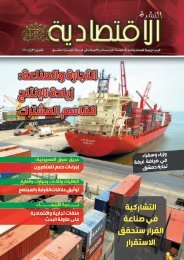SIGAR
2017-01-30qr
2017-01-30qr
Create successful ePaper yourself
Turn your PDF publications into a flip-book with our unique Google optimized e-Paper software.
SECURITY<br />
across Afghanistan. 322 The night-vision capable SMW provides all the Afghan<br />
special forces helicopter support. 323<br />
<strong>SIGAR</strong> will report on the details of the SMW budget, manpower, and<br />
capabilities in a classified annex to this report.<br />
AFGHAN NATIONAL POLICE<br />
As of December 31, 2016, the United States had obligated $20.2 billion and<br />
disbursed $19.8 billion of ASFF funds to build, train, equip, and sustain<br />
the ANP. 324<br />
ANP Staff at the National Logistics Center<br />
in Wardak hosted Maj. Gen. Richard Kaiser,<br />
commander of CSTC-A, as he reviewed the<br />
facility and supply levels in preparation for<br />
the winter season. (CSTC-A photo)<br />
ANP Strength Decreases for the First Time in a Year<br />
As of November 20, 2016, the overall assigned end strength of the ANP,<br />
including the Afghan Uniform Police (AUP), Afghan Border Police (ABP),<br />
Afghan National Civil Order Police (ANCOP), and MOI Headquarters and<br />
Institutional Support (MOI HQ & IS), was 147,635, according to USFOR-A. 325<br />
This is a decrease of 845 ANP personnel since last quarter, which marks the<br />
first time in a year that ANP end strength has decreased. 326 However, this<br />
quarter’s figure is 1,609 personnel more than at this time in 2015, and the<br />
ANP are currently at 94% of their authorized end strength. 327<br />
Patrol personnel represent the largest subset of the ANP this quarter<br />
with 69,749 members; noncommissioned officers numbered 50,551, while<br />
officer ranks stood at 27,335. 328 Notably, the largest decrease in personnel<br />
this quarter occurred within the smallest subset of the ANP, 395 fewer officers,<br />
followed by 346 fewer patrol personnel. 329<br />
Table 3.11 provides the six-month change in the strength of the ANP’s<br />
components (e.g. AUP, ABP, ANCOP) from April 2016 to October 2016.<br />
During that time, the ANP suffered a loss of 1,578 personnel. 330<br />
TABLE 3.11<br />
ANP STRENGTH, SIX-MONTH CHANGE<br />
Authorized<br />
Assigned<br />
ANP Component Q2 2016 Q4 2016<br />
6-Month<br />
Change Q2 2016 Q4 2016<br />
6-Month<br />
Change<br />
AUP 88,031 88,014 (17) 86,234 85,188 (1,046)<br />
ABP 25,015 23,322 (1,693) 21,654 20,982 (672)<br />
ANCOP 17,061 17,060 (1) 15,458 15,460 2<br />
MOI HQs & IS 28,593 28,604 11 25,867 26,005 138<br />
ANP Total *<br />
(as reported) 158,700 157,000 (1,700) 149,213 147,635 (1,578)<br />
Note: Quarters are calendar-year; Q2 2016 data as of 6/2016; Q1 2016 data as of 11/2016. AUP = Afghan Uniformed<br />
Police; ABP = Afghan Border Police; ANCOP = Afghan National Civil Order Police; IS = Institutional Support personnel.<br />
*NISTA (Not In Service for Training), generally students, and standby personnel, generally reservists, are not included in the<br />
above “ANP Total” figures. The Q4 2016 assigned strength does not include the 4,894 NISTA or 2,048 standby personnel.<br />
Source: USFOR-A, response to <strong>SIGAR</strong> data calls, 6/3/2016 and 11/20/2016.<br />
110<br />
SPECIAL INSPECTOR GENERAL I AFGHANISTAN RECONSTRUCTION







